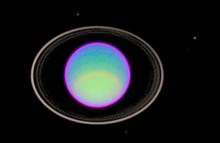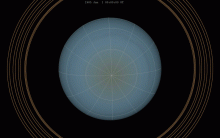Listen to today's episode of StarDate on the web the same day it airs in high-quality streaming audio without any extra ads or announcements. Choose a $8 one-month pass, or listen every day for a year for just $30.
You are here
Moon and Uranus
The gibbous Moon takes aim at the planet Uranus tonight. And for skywatchers in the western part of the United States, it’ll catch it — the Moon will pass in front of the giant planet, briefly hiding it from view.
Uranus is the Sun’s third-largest planet — four times the diameter of Earth. Most of its bulk consists of a slushy mix of water, methane, and other compounds, with a solid core of rock and metal.
Scientists know about the interior in several ways. They can measure the planet’s gravitation pull on other planets and on its own moons. That reveals the planet’s mass. They also know its distance, which reveals its size. From that, they calculate its density — less than any other planet except Saturn.
Next, they use computer models to simulate what materials came together to make the planet, and how the planet might have evolved over the eons. And that gives them a rough idea of its composition and structure.
To get more detail about the planet’s structure, we’ll need to send more spacecraft. As they pass close to the planet, they can produce much better maps of its gravitational field — providing a good look at what’s going on inside this giant planet.
Tonight, the Moon will pass in front of Uranus around 1 a.m. Central Time, and will hide it for a few minutes. For most of the country, the two will just miss each other. Through a small telescope, Uranus will look like a tiny star sliding just below the Moon.
Script by Damond Benningfield





